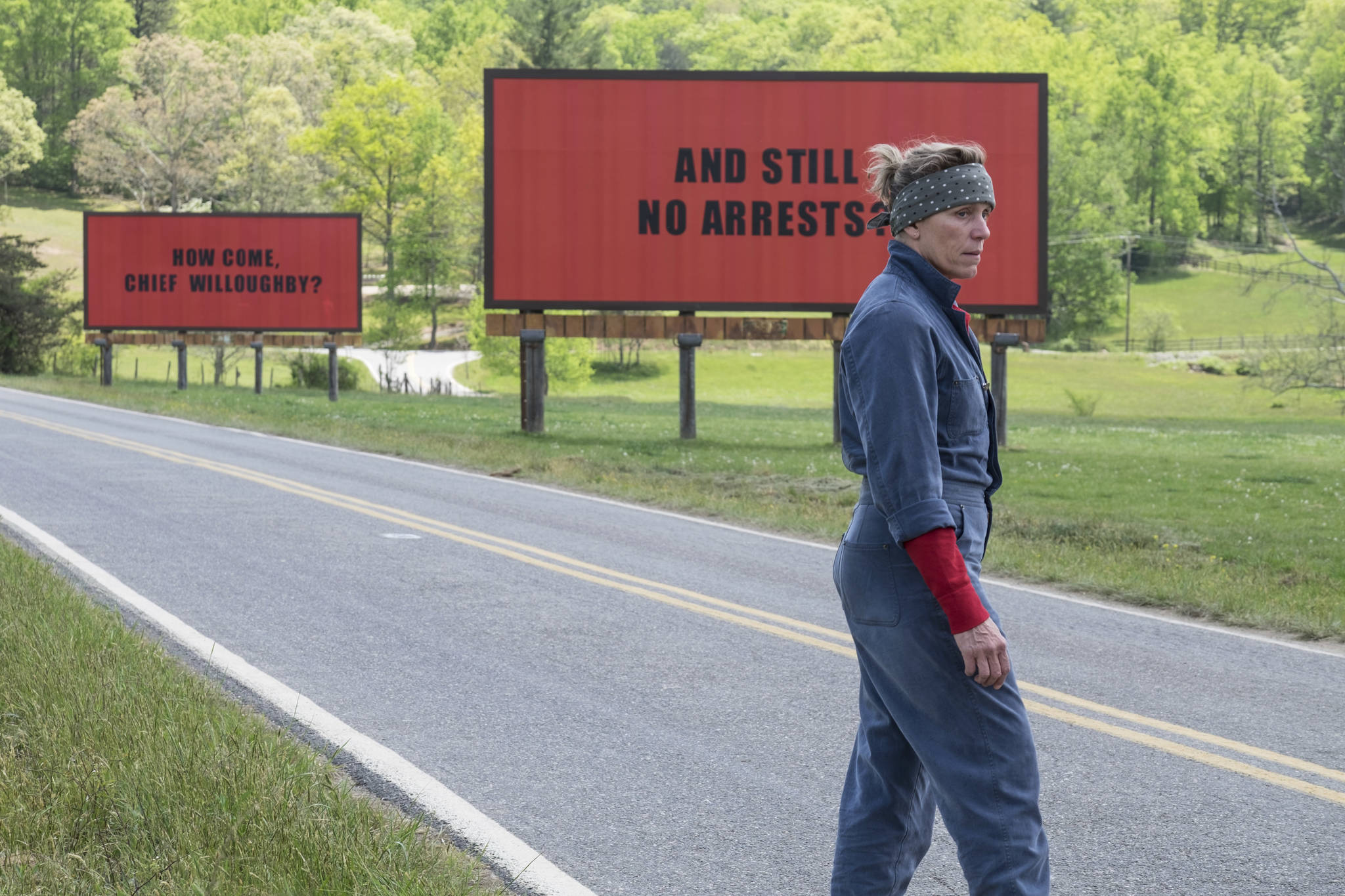“Three Billboards Outside
Ebbing, Missouri”
1 hour, 55 minutes
I have to say at the outset of this review that, while (spoiler alert) I did not like this week’s movie, the multiple Oscar-nominated “Three Billboards Outside Ebbing, Missouri,” it is worth going to see for at least two reasons.
For one, the film creates interesting discussions, not only about race and economic disparity in America, but about filmmaking and screenwriting as well. For another, going to see this film will encourage our local theaters to bring in more movies like this. Unfortunately, by the time you read this, the movie will probably be gone, but maybe not.
Regardless, anytime these theaters step outside of their comfort zone and bring in something original and somewhat unusual, I applaud the effort.
So what’s wrong with this movie? Enough that no mere edit or reshoot would help. The problems in this film are deep within the structure — some of the issues are part of what make the film interesting to watch, but just because something is interesting doesn’t mean it makes sense.
Francis McDormand plays Mildred Hayes, a thoroughly unlikeable woman, though a pitiable one due to the horrifying rape and murder of her teenage daughter some eight months prior. Mildred is frustrated with the lack of progress from the local police department on her daughter’s murder, and upon coming across three abandoned billboards outside of town, she comes up with an idea. She rents the billboards and has bright red signs posted that outline exactly what happened in no uncertain terms. The phrases are short and sweet — from an advertising perspective, it’s genius. In the final billboard, she calls out popular sheriff Bill Willoughby by name, the final straw in this conservative, quiet little town.
Willoughby, played by Woody Harrelson, sympathizes with Mildred’s frustration, but literally has done all he can on her case. A complete lack of evidence or eyewitnesses has halted all progress, and now it’s a waiting game. Waiting on a break in the case is one thing, but the town can’t wait for Mildred Hayes to take down her billboards — something Millie has no intention of doing.
“Three Billboards” has a lot going for it. Written and directed by famed Irish playwright Martin McDonough and boasting a talented cast, you would think this film would be a cinch to win awards. And it has.
But the film has also been deeply polarizing, dividing those who find its strangely twisting plot and entertainingly written characters fascinating, and those, like me, who find the film to be deeply inauthentic and whose interesting plot is also mostly nonsensical.
Looking at the overall plot of the film, McDonough seems to be making a film that is, at least in part, commenting on the racial situation in the American South. Now, whether you consider Missouri the south is debatable, but at the very least, the film feels like it takes place in the South.
Sam Rockwell plays Officer Dixon, the requisite racist cop, and the representative of the town’s racist past, though it has mostly moved into modern times. The screenplay goes to great lengths to describe Dixon as a terrible person, a misogynist homophobic drunk who can barely string three sentences together and who, at some point in the past, the film makes clear, engaged in the torture of a black detainee. It’s hard to imagine an officer this incompetent and plainly unfit ever being allowed on the force, but obviously, that’s the comment. Fair point. It happens.
My problem is how the film treats these character flaws not as deep seated issues, but as quirks, almost charming eccentricities of this shaggy dog character. Dixon pays few consequences for his actions, a trend in this town where no one ever seems to be held accountable for anything. Much of what he does makes no logical sense — a problem shared film-wide. Without going through instance by instance, most of the major characters take actions that fly in the face of logic, actions that seem designed to move the plot toward an inevitable breaking point, but make no sense otherwise.
My other main issue with the film was the language. I’m not opposed to foul language in films. “The Big Lebowski” is one of my favorite films and that’s certainly not one you’re going to watch in mixed company. The problem with the constant cursing in this movie is that it feels false, especially in a film that seems to want to be taken seriously.
It’s not that I don’t believe that the people in Ebbing, Missouri cuss, it’s that they don’t cuss like this — in this particularly Irish/British fashion, where certain words don’t carry the same weight and connotation they do here. It’s this inauthenticity in the language that I think reveals the cracks in McDonough’s understanding of Middle American and Southern small town life. So much of it rings untrue.
“Three Billboards” is definitely interesting, with lots of unexpected plot turns and incredible performances. McDormand is excellent — her misery turned to anger. Her chemistry with Harrelson, as the sheriff, is beautifully done, and I enjoyed the scenes between them. Rockwell is an amazing actor who doesn’t get seen often enough. He does a great job here, at least from an acting perspective.
I blame none of the performers — I blame McDonough, whose best film “In Bruges,” is one of my favorites. McDonough swings for the fences here trying to make a scrappy Irish character drama set in the American South, and it just doesn’t work. I wanted to be into it, but “Three Billboards” kept me strictly on the outside.
Grade: C-
“Three Billboards Outside Ebbing, Missouri” is rated R for pervasive language, violence, and sexual references.
Chris Jenness is an art teacher, freelance graphic designer, artist and movie buff who lives in Nikiski.

